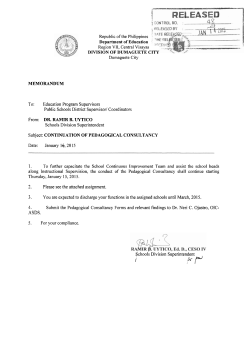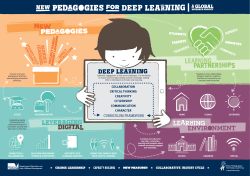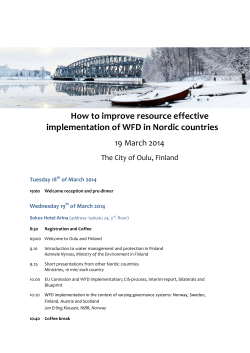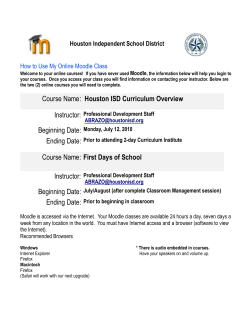
D. 2.3. DIYLab Specifications: Finnish Primary & Secondary School
D. 2.3. DIYLab Specifications: Finnish Primary & Secondary School Do It Yourself in Education: Expanding Digital Competence To Foster Student Agency And Collaborative Learning European Commission Educations Audiovisual and Culture Executive Agency -71400ALLPA4A3541A4AESAKA1MP 1 2.3. DIY Lab Specifications - Finnish Primary & Secondary School Authors: University of Oulu. Antti Peltonen, Mikko Ojala, Paula Airaksinen, Esa Niemi Collaborators: Oulu University Teacher Training School Kerttuli Saajoranta, Seija Blomberg, Pasi Hieta, Kari Kumpulainen 1. INTRODUCTION This report reflects the process and the outcomes of the design of the DIY Lab. Its aim is to sum up the explorations and decisions, made by the primary and secondary teachers of Teacher Training school of The University of Oulu. They are the group, which will be in charge of the implementation of DIYLab (WP4). The formation is part of the process initiated in WP1. Teacher Training school of The University of Oulu has two separate school units which are operating in different locations: Koskela-primary school and Linnanmaa-secondary school. The schools are teacher training schools and they have regularly teacher students practicing, in other respect they are about ordinary local schools. The timeframe for the planning activity was between July and December 2014. The main work for the report was done with the 13 primary and secondary teachers, with principals and with the support of three researchers of the University of Oulu. Planning of DIYLab and preparation started at October 2014. First meetings for implementation were between university experts, school principals and key teachers. Since then both schools have had briefing sessions for all teachers. Teachers who will implement DIYLab activities have had several more specified sessions. To support planning, university opened Moodle-online environment, where teachers can discuss with each other in native language and find topic related resources, like net videos and links to materials. The four key topics of the DIYLab specification are: 1. 2. 3. 4. What is DIY philosophy and what are the pedagogical principles inside it? From the vision to the classroom – What DIYLab means in our school? The tools,devices and applications etc. Relation between DIYLab and curriculum 2 2. Revising the pedagogical principles Selected online videos, which were visible in Moodle, were provided by the university, as a pedagogical background for the DIY philosophy. Themes of the videos originate from WP1 and project discussions. We found out that online forum discussions in Moodle were quite limited but the ideas from the background materials were on the table in later face to face discussions between teachers. Background videos and online links reflect well also the basic pedagogical principles which were exploited in DIYLap plans. However planning and discussion were needed to apply the general pedagogical and methodological ideas to the school. Most of the following videos and materials are in Finnish. Names are translated for this report. Links and tips for project based learning and evaluation (http://www.avoinvirta.fi/?p=61622) Process evaluation as a tool for a teacher, a pupil and peers. (Ministry of Education, 2008) YouTube-video: Piloting culture. Sitra, the Finnish Innovation Fund, 2012 ICT and pedagogical use. SlideShare. Matleena Laakso, 2014 Article about creativity and learning in school, Helsingin Sanomat 9/2014 Innovative and developing school by means digital technology. Video. Liisa Ilomäki ( http://www.ede.fi/moodle/mod/page/view.php?id=3612 ) ICT and new 2016 curriculum. Video. Jukka Tulivuori, Ministry of Education, 2014. (http://www.ede.fi/moodle/mod/page/view.php?id=3407 ) Set of pedagogical models and sense of community in online learning. Video. Virpi Pietikäinen, 2014 (http://www.ede.fi/moodle/mod/page/view.php?id=3284 ) o Discovery learning. Hakkarainen (1998);Hakkarainen, Lonka, Lipponen, (1999;2004) o Problem Based Learning. Poikela, Poikela (2005) o Future Learning Environments. Kirsti Lonka (10/2014) o Flipped learning o ProjectBased Learning o Phenomenon-based learning. Pedagogical aspects of DIYLab were also on a discussions in two poster sessions: (1) National teacher training school network symposium in Joensuu 30.10. 2015 and (2) Educational science conference in University of Oulu, where the poster was in Facebook page for comments on 5.-18.11.2015. Trend in verbal comments of the poster session was that in theory the pedagogical approach is good and eligible but in school practice there will be challenges. 3 3. From the vision to the classroom – What DIYLab means to me and in our school? Theoretical and methodological framework was well accepted but teachers’ way of thinking was surprisingly straightforward towards the implementation. The challenge was, and will be, how to maintain innovative approach in a pressure of school routines and boundaries of the curriculum. However, teachers creatively convert the theory into practice via goals and questions to students, like: “Where am I good at?” “What I already know well?” According to the teachers’, the motto of the project “Do it yourself” should be extended to: “Help me to do it myself!” One challenge in teacher training school is that the teaching what combines subjects, requires cooperation between the teacher of the didactics, who usually observes and guides only one subject and its lessons. However, the new curriculum 2016 emphasizes transdisciplinary knowledge and this may renovate also practices of the teacher training. In this sense DIYLab is in line with the future. Several comments from the meetings express concern how to handle and arrange the situation in a class size group: It’s a challenge to get rid of a conservative teaching culture. Digital surroundings gives freedom to teachers and learners (although digital tools are equipment. - Not a method) so that teachers can devote more time to the weaker students of the group. In primary school it is not easy to guide pupils to do things by themselves. There is all the time an effort to promote team work. In secondary school, a school day is made up from school subjects and lessons. DIYLab teachers put a lot of effort to combine lessons and subjects and this naturally generated co-operation between teachers. Teachers thought, that it is important to involve parents to the project, but so far the ideas and plans are related only to informing. Both teachers and principals of the schools consider that the best way to plan DIYLab actions is to start with pupils, classes, timeframes, subjects and other concrete things. Starting point of the university experts were more from theory and methods to practicalities. Differences on approaches did not mean conflict with pedagogical or philosophical approach of DIYLab, more like that teachers wanted to ensure that plans are feasible and DIYLab actions are sustainable. We believe that the teachers have a clear vision about DIYLab pedagogy and ideology. Arising from that starting point, principals face the challenge, how to encourage the teachers to think innovatively and even break boundaries if needed. Another big challenge is make the new actions possible, regarding timetables, rooms and other resources. 4 Primary school DIYLab activities. (Timeframe: March - May 2015): Theme 1:”Force” –Thematic school subject integration (Crafts, Physics and chemistry, Mother tongue and literature, Music, Finnish as a Second Language, English) Class: 5A, 5B Teachers: Terho Granlund, Matti Mikkonen, Hanna-Maija Heikkinen, Helena Nissilä Secondary School DIYLab activities. (Timeframe April-May 2015): Theme 2: ”Europe yesterday and today” (Geography, History) Class: 8C Teachers: Juha Wedman, Matti Ojakoski Theme 3: “Traffic -Behavior, road safety, environmentalism” Class: 8B, 8C Teachers: Hanna Tuhkanen, Terhi Ylöniemi, Hellevi Kupila, Riikka Kiiveri-Raappana Theme 4: “North-America and immigration throughout history” Class: 7B Teachers: Katrimaija Lehtinen-Itälä, Virpi Sivonen-Sankala Theme 5: “Light as wave motion” (Physics) Class: 7B Teacher: Eero Ijäs 5 4. The devices and applications, programs and other tools Both schools have quite good ICT-infrastructure and it will be used widely in activities. Teachers have also made plans to get the work process and product documented by videos and photos, bearing in mind that the practices will be shared through DIYLab hub. Primary School ICT-infrastructure, which is available for the activities Computer class rooms (PC for every pupil.) iPad tablets for one class (Bookable for lesson use. Specific Apps can be bought if needed. Several already available, like iStopMotion. on ten tablets) School web portal for information WiFi-network available Google Apps For Education Secondary school ICT-infrastructure, which is available for the activities: Computer class rooms 32 iPad tablets (Bookable for lesson use. Specific Apps can be bought if needed.) School web portal for information WiFi-network available Google Apps For Education Primary school activity “Force” contains mechanical and technical materials and digital actions and there is a good possibility to develop and observe DIY-approach, what combines both worlds. 6 5. Relation between DIYLab and curriculum – How the actions we have planned, supports the goals of the curriculum Because of the sensible and practical approach by the teachers, plans for the DIYLab actions are within the frames of the current curriculum. The curriculum in Finland is relatively free, concerning e.g. methods, so it is quite easy to blend DIYLab ideology into work, even though the curriculum dictates the topics and the core contents. One big incentive to DIYLab work is that Finland is right now in a process to reform the national Curriculum. The new curriculum in 2016 opens the possibility to explore new ways to teach and learn. Related to that big change and DIYLab, teachers have had several discussions what should be taught and how. If one reflects the philosophy of the DIYLab into seven dimensions of a broad based competence, it is easy to see that the tone of the curriculum and DIYLab are in balance. 1. 2. 3. 4. 5. 6. 7. Thinking and learning to learn Cultural competence, interaction and expression Looking after oneself, managing daily activities Multiliteracy ICT competence Competence required for working life and entrepreneurship Participation, empowerment and responsibility The new coming curriculum gives a good direction to the DIYLab activities but it has to meet also the requirements of the current curriculum. Many of the content related things are binding and even legal protection of the students requires attention and all actions have to happen in these frames. 7
© Copyright 2025





















